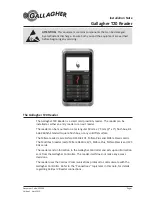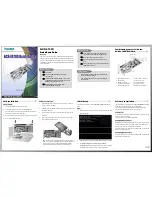
10
DIGITAL I/O CARD–16
The input impedance of each isolated input is approximately 560 ohms (factory
default). The opto-isolator requires approximately 3 mA to power on. The
maximum input current is 60 mA. You must consider two things when selecting the
input resistor: The first is power-on voltage for the circuit to sense, and second is
the maximum input voltage. Maximum input voltage must not provide too much
power to the input resistor, and it must also not overdrive the opto-isolator input
current specification. The following formulas apply:
Power-on current: 3 mA
Isolator diode drop: 1.1 V
Resistor power max.: 0.25 W
Power-on voltage = diode drop + (turn-on current) x ( resistance)
Or :
1.1 + (.003) x R
Maximum voltage = square root of (0.25 [resistor value])
Table 2-2 shows four common input resistors and the ranges associated with each.
Table 2-2. Input resistor ranges.
Input Resistor
Value Power-On
Max. Input Range
Max. Current
(ohms)
(volts)
(volts)
(mA)
220
1.76
7
27
560
2.8
12
20
1K
4.1
16
15
2.2K
7.7
24
10
The maximum input voltage can be increased by increasing the input resistor
accordingly. Because socketed DIP resistor networks are used, they can easily be
replaced with a different value. This can be done at the factory, if necessary. The
input circuits are not intended for monitoring 120-volt AC circuits. In addition to
being too high a voltage for the circuits, it is dangerous to have that high a voltage
on the card.
Table 2-3 lists the input ports pin assignments.





































